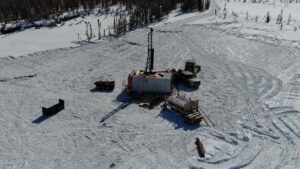Corazon launches into mining studies at Lynn Lake nickel project

Pic: John W Banagan / Stone via Getty Images
Mining studies are underway at Corazon’s (ASX:CZN) Lynn Lake nickel-copper-cobalt sulphide project, where large, high-quality resources and established infrastructure provide an excellent foundation for the potential restart of operations.
Junior explorer Corazon managed to consolidate the entire historic Lynn Lake nickel-copper-cobalt mining centre in Canada and has since established a significant JORC resource of 116,800t of nickel, 54,300t copper and 5,300t of cobalt.
The resource has significant expansion potential, the company says.
It is the first time this project has been under the control of one company since the mine — which produced about 206,200 tonnes of nickel and 107,600t copper over 24 years — closed in 1976.
Since the mine closed, there have been huge advances in mining techniques, rock mechanics, materials handling and processing, the company says.
“The mining and processing methods at the old Lynn Lake Mining Centre were developed in the 1950s and carried through to mine closure in 1976,” Corazon managing director Brett Smith says.
“We have already proven with our metallurgical studies that we can produce and deliver a much higher quality nickel and copper concentrate than that historically produced.
“We think we can deliver similar benefits, by considering modern mining practices, more suited to the current resource (not the resource they had in the 1950s) and existing infrastructure.
“The current JORC resources within the mining centre were defined late in the mine’s history, with the majority of these resources contained in two large deposits — drilled out and developed, ready for mining.”
The new phase of mining studies being undertaken by Corazon will use current mining tech and practices to define the best development pathway for a “robust, long-lived, economically viable mining operation”.
With expectations of a rapidly increasing global market for quality Class-1 nickel to meet rising demand from the EV sector, Lynn Lake presents an excellent redevelopment opportunity, Corazon chairman Terry Streeter says.
“We have the opportunity to completely redefine a mining operation at Lynn Lake by incorporating modern technology and a modern approach, to optimise the project’s geology and infrastructure,” he says.
“Previous mining studies for the Lynn Lake Project utilised mining and processing practices from the 1950s.
“We think that there is a significant opportunity to pursue the development of a substantial modern mining operation by leveraging current mining practices, more suited to the project’s significant resource base.”
Growing the resource
Recent work at Lynn Lake has focused on regional exploration, in particular drill testing geophysical anomalies at the Fraser Lake Complex (FLC), ~10km south of the Lynn Lake Mining Centre.
In November, a geophysical survey identified a large area of conductance in a new area to the west of the FLC.
Subsequent drilling of these targets intersected favourable host rocks for nickel sulphide and extensive indications of magmatic sulphides.
Down-hole electromagnetic (DHEM) testing of this drilling in April identified large off-hole conductors that may represent strong accumulation of magmatic nickel-copper-cobalt sulphides.
EM surveys map sub-surface changes in electrical conductivity and are a useful tool for finding nickel sulphides.
Drill testing of the conductor plates defined by the DHEM surveys and the new more discrete anomalies defined by recent reprocessing of the MobileMT data “are a priority”, the company says.
Drilling is expected to be undertaken once ground conditions improve, subsequent to the spring melt, which is currently in progress.
This article was developed in collaboration with Corazon, a Stockhead advertiser at the time of publishing.
This article does not constitute financial product advice. You should consider obtaining independent advice before making any financial decisions.
Related Topics
UNLOCK INSIGHTS
Discover the untold stories of emerging ASX stocks.
Daily news and expert analysis, it's free to subscribe.
By proceeding, you confirm you understand that we handle personal information in accordance with our Privacy Policy.








